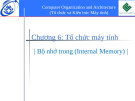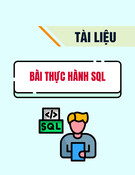
Software architecture
£The design process for identifying the sub-systems
making up asystem and the framework for sub-
system control and communication is architectural
design.
£The output of this design process is adescription
of the software architecture.
4
CuuDuongThanCong.com https://fb.com/tailieudientucntt

Architectural design
£Is an early stage of the system design process.
£Represents the critical link between specification
and design processes.
£Often carried out in parallel with some specification
activities.
£Involves identifying major system components and
their communications.
5
CuuDuongThanCong.com https://fb.com/tailieudientucntt




![Bộ câu hỏi trắc nghiệm Nhập môn Công nghệ phần mềm [mới nhất]](https://cdn.tailieu.vn/images/document/thumbnail/2025/20251111/nguyenhoangkhang07207@gmail.com/135x160/20831762916734.jpg)
























